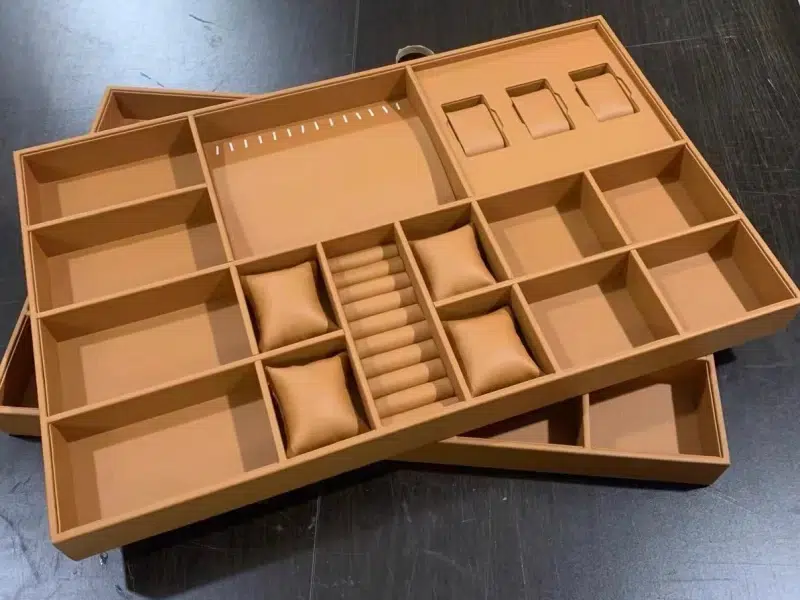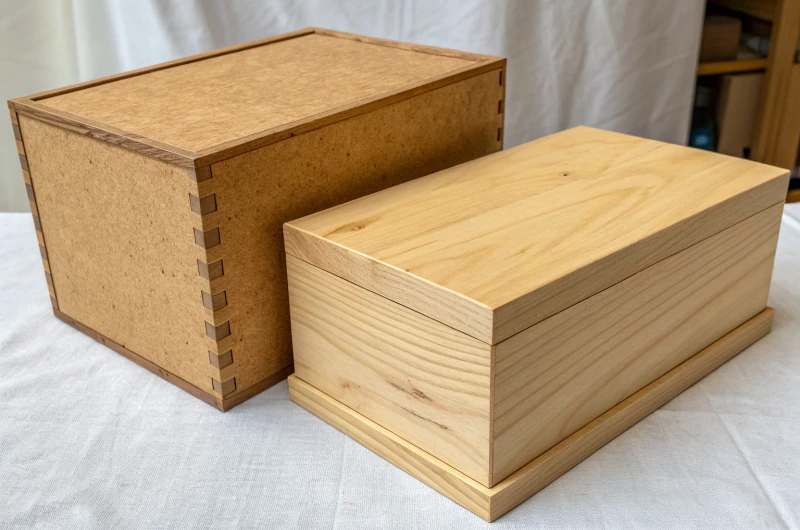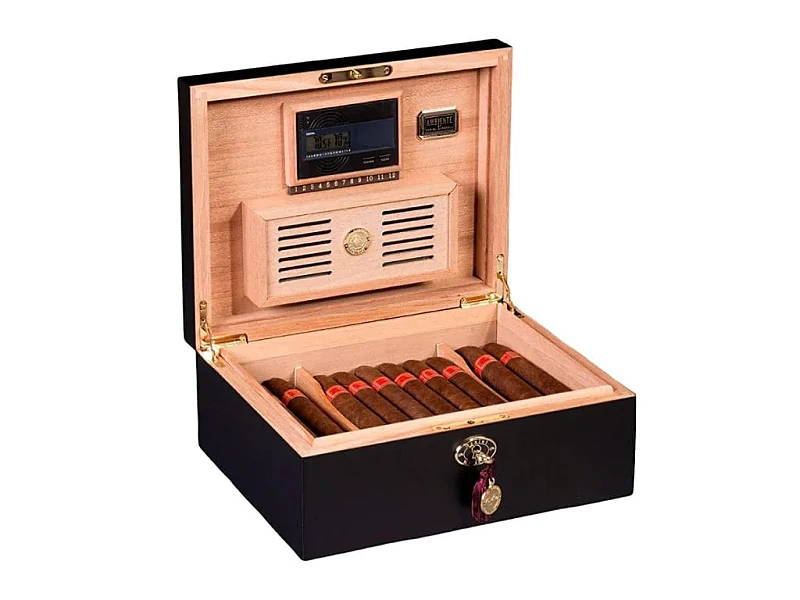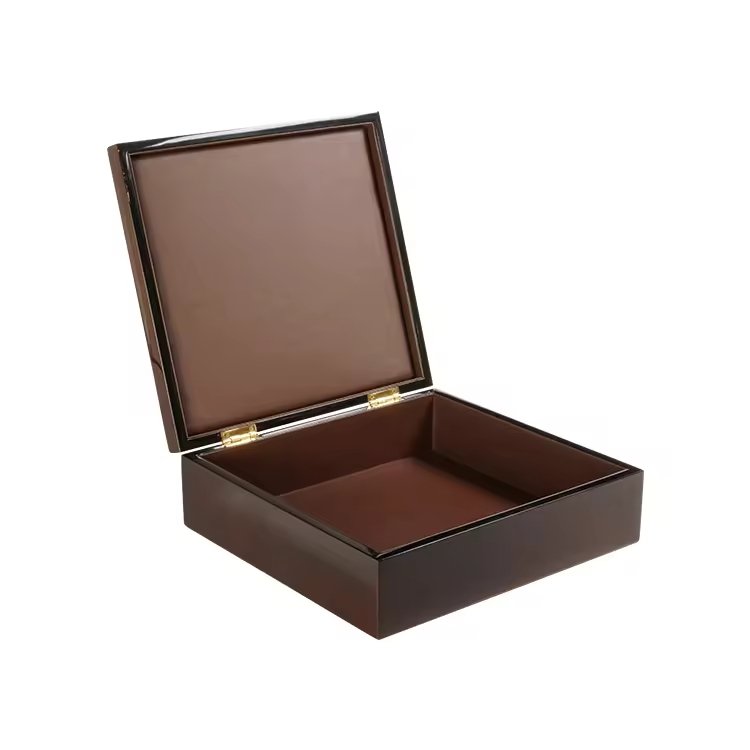
Un hermoso interior de joyero puede arruinarse por una sola costura de cuero PU burbujeante o suelta.
Por eso, la elección del adhesivo no es sólo técnica: define la experiencia visual y táctil.
A lo largo de los años, he trabajado en innumerables proyectos de joyeros de lujo, y el mayor problema que subestiman los clientes es la calidad del adhesivo. Exploremos las mejores prácticas de encolado para aplicaciones de cuero PU duraderas y sin costuras, especialmente en superficies intrincadas.
¿Por qué es fundamental la elección del adhesivo para el pegado de cuero PU a largo plazo?
El cuero PU es un material sintético con una base de plástico que se comporta de forma diferente al cuero natural o al tejido. Se:
- Requiere adhesivos de alta adhesión1 para un agarre duradero
- Es propenso a burbujeo superficial2 si los adhesivos no son compatibles
- Puede delaminarse con el tiempo con el fórmula incorrecta del pegamento3
- Espectáculo de mayo marcas o decoloración si el adhesivo es demasiado agresivo
| Tipo de fallo adhesivo | Efectos visibles en el joyero |
|---|---|
| Levantamiento o descascarillado de los bordes | Artesanía defectuosa |
| Burbujeo superficial | Apariencia barata |
| Sangrado o manchas de pegamento | Estropea la estética interior |
| Adherencia débil en curvas | Reduce la longevidad |
✔ Para los envases de lujo, el rendimiento del adhesivo debe estar a la altura del precisión del propio diseño de la caja.
¿Cuáles son los tipos de adhesivo más eficaces para superficies curvas e intrincadas?
No todos los adhesivos funcionan bien en contornos tridimensionales o soportes de PU delicados. Estos son los tipos más fiables que utilizo basándome en pruebas reales:
1. Cemento de contacto con disolventes
- Excelente adherencia inicial y fijación a largo plazo
- Ideal para curvas cerradas y esquinas4
- Seca rápido - mejor con una aplicación experta
2. Adhesivos PU base agua5
- Más seguro para los trabajadores y respetuoso con el medio ambiente
- Un tiempo de virado más lento permite una mejor alineación
- Es menos probable que dañe la espuma o el núcleo de fibra
3. Pegamento termofusible PU6 (para automatización)
- Utilizado en interiores envueltos con CNC
- Adhesión limpia y fuerte, pero requiere un soporte resistente al calor
| Tipo de adhesivo | El mejor caso de uso | Punto de Atención |
|---|---|---|
| Cola de contacto con disolventes | Esquinas afiladas, juntas estructurales | Debe ventilar los humos |
| Cola PU a base de agua | Paneles planos, dorso transpirable | Secado más lento: necesita tiempo de presión |
| Pegamento termofusible (PU) | Embalaje robotizado/automatizado | Puede deformar el PU fino si se sobrecalienta |
✔ A menudo técnicas de mezcla-Pegamento de contacto para bordes detallados, adhesivo de base acuosa para paneles grandes.
¿Cómo se evitan las filtraciones de cola o el burbujeo de la superficie durante la aplicación?
Incluso el mejor adhesivo puede causar problemas si la aplicación es apresurada o incoherente.
Buenas prácticas:
- Utiliza un rodillo o un pincel fino para pegar para una distribución uniforme
- Aplique una capa fina y consistente en ambas superficies
- Permitir tiempo de virada antes de prensar la PU para darle forma
- Utilice moldes de prensa o herramientas de bordes curvos para aplicar presión uniformemente
- Evite estirar demasiado el cuero PU, ya que el pegamento se despega de su sitio.
| Error | Problema resultante |
|---|---|
| Encolado excesivo | Filtraciones a lo largo de las costuras |
| Adhesión inmediata | Provoca burbujas por vapores atrapados |
| Presión desigual | Adherencia irregular y ondulaciones superficiales |
✔ Mi regla personal: probar cada nuevo lote de cuero PU con pegamento en una pequeña muestra-Los materiales varían sutilmente de un lote a otro.
¿Qué factores afectan al tiempo de secado y a la trabajabilidad en el revestimiento interior detallado?
Necesita tiempo para trabajar en costuras, esquinas y pliegues, pero no quiere esperar eternamente. El tiempo de secado depende de:
- Humedad y temperatura ambiente7
- Grosor de la capa de cola8
- Material del sustrato9 (la madera absorbe más rápido que el núcleo de plástico)
- Flujo de aire en el taller
| Medio ambiente | Efecto sobre la trabajabilidad del adhesivo |
|---|---|
| Humedad elevada | Secado más lento, riesgo de fianza más débil |
| Clima cálido/seco | El pegamento se despega demasiado rápido |
| Baja ventilación | Secado irregular |
✔ En la mayoría de los casos prensar los interiores durante 12-24 horas utilizando pesos ligeros para garantizar una adherencia uniforme.
¿Cómo puede garantizar una fuerte adherencia sin dañar los delicados materiales de revestimiento?
Algunos interiores de PU están reforzados con papel de fibra, esponja o microfibraque pueden dañarse con colas agresivas.
Soluciones:
- Elija adhesivos al agua con bajo contenido en COV para forros delicados
- Utilice parches de prueba comprobar si hay arrugas o manchas
- Aplique una capa de imprimación barrera sobre MDF poroso o base de madera antes de pegar
- Evite el calor excesivo durante el pegado, ya que puede deformar la espuma o levantar la veta.
✔ Haga coincidir siempre el pegamento viscosidad y pH a la suavidad del material: las fórmulas duras encogen el PU blando con el tiempo.
¿Qué métodos de ensayo ayudan a confirmar la durabilidad y un acabado limpio y lujoso?
Antes de pasar a la producción total, siempre pruebo de 3 a 5 cajas de muestra en condiciones reales.
Controles de calidad esenciales:
- Prueba de pelado10: Aplique presión y tire después de 24 horas
- Exposición al calor11: Simulación de 40°C para imitar el verano
- Inspección de bordes: Compruebe si hay arrugas, estrías o sangrado del pegamento
- Prueba de olor: Las colas con disolventes deben estar totalmente limpias antes del encajado.
- Revisión final12: Inspeccionar bajo una luz angular en busca de ondulaciones o brillo del pegamento.
✔ Una caja puede ser preciosa a la luz del día, pero la luz dura revela cada costura y arruga.
Conclusión
El adhesivo adecuado transforma el cuero PU de un simple revestimiento en una experiencia lujosa y duradera.
Para hacerlo bien:
- Emparejar el fórmula adhesiva a sus materiales y método de aplicación
- Controla tu entorno y tiempo de presión
- Utilizar el derecho herramientas para esquinas, curvas y estratificación
- Siempre pruebe su técnica de adhesión antes de aumentar la producción
Porque en los interiores de lujo, un acabado impecable siempre empieza por lo que hay debajo.
Marca: WoodoBox
Eslogan: Cajas de madera personalizadas, hechas a la perfección
Página web: www.woodobox.com
-
Conocer los adhesivos de alta adherencia puede ayudarle a elegir el adecuado para pegar cuero PU de forma eficaz. ↩
-
Aprenda sobre el burbujeo de la superficie para evitar errores comunes en sus proyectos de adhesivos y garantizar un acabado impecable. ↩
-
Descubra los riesgos de utilizar una fórmula de cola incorrecta para evitar la delaminación y garantizar la durabilidad de sus proyectos. ↩
-
Explore este enlace para descubrir los adhesivos más eficaces, diseñados específicamente para curvas cerradas y superficies intrincadas, que garantizan una unión fuerte. ↩
-
Conozca las ventajas de los adhesivos PU de base acuosa, como su respeto por el medio ambiente y su idoneidad para materiales delicados. ↩
-
Descubra cómo se utiliza el pegamento PU termofusible en procesos automatizados, garantizando uniones limpias y fuertes en la fabricación. ↩
-
Comprender cómo afectan la humedad y la temperatura al secado puede ayudarle a optimizar su proceso de envoltura para obtener mejores resultados. ↩
-
Explorar los efectos del grosor de la cola puede mejorar la adherencia y la eficacia de sus proyectos. ↩
-
Conocer los distintos materiales de sustrato puede ayudarle a elegir las mejores opciones para sus necesidades de envoltura. ↩
-
Comprender el ensayo de pelado puede mejorar su conocimiento de los métodos de aseguramiento de la calidad, garantizando una mayor durabilidad del producto. ↩
-
Explorar las pruebas de exposición al calor le ayudará a comprender cómo afecta la temperatura a la durabilidad de los envases, algo crucial para las entregas en verano. ↩
-
Una revisión del acabado es vital para conseguir un aspecto lujoso; aprenda más para garantizar que sus productos destaquen. ↩





